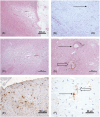Insights into the pathological basis of dementia from population-based neuropathology studies
- PMID: 37462105
- PMCID: PMC10946587
- DOI: 10.1111/nan.12923
Insights into the pathological basis of dementia from population-based neuropathology studies
Abstract
The epidemiological neuropathology perspective of population and community-based studies allows unbiased assessment of the prevalence of various pathologies and their relationships to late-life dementia. In addition, this approach provides complementary insights to conventional case-control studies, which tend to be more representative of a younger clinical cohort. The Cognitive Function and Ageing Study (CFAS) is a longitudinal study of cognitive impairment and frailty in the general United Kingdom population. In this review, we provide an overview of the major findings from CFAS, alongside other studies, which have demonstrated a high prevalence of pathology in the ageing brain, particularly Alzheimer's disease neuropathological change and vascular pathology. Increasing burdens of these pathologies are the major correlates of dementia, especially neurofibrillary tangles, but there is substantial overlap in pathology between those with and without dementia, particularly at intermediate burdens of pathology and also at the oldest ages. Furthermore, additional pathologies such as limbic-predominant age-related TDP-43 encephalopathy, ageing-related tau astrogliopathy and primary age-related tauopathies contribute to late-life dementia. Findings from ageing population-representative studies have implications for the understanding of dementia pathology in the community. The high prevalence of pathology and variable relationship to dementia status has implications for disease definition and indicate a role for modulating factors on cognitive outcome. The complexity of late-life dementia, with mixed pathologies, indicates a need for a better understanding of these processes across the life-course to direct the best research for reducing risk in later life of avoidable clinical dementia syndromes.
Keywords: Alzheimer's disease; Lewy body disease; dementia neuropathology; epidemiological neuropathology; population-representative neuropathology; vascular dementia.
© 2023 The Authors. Neuropathology and Applied Neurobiology published by John Wiley & Sons Ltd on behalf of British Neuropathological Society.
Conflict of interest statement
There are no conflicts of interest.
Figures





References
-
- Brayne C, McCracken C, Matthews F. Cohort profile: the Medical Research Council cognitive function and ageing study (CFAS). Int J Epidemiol. 2006;35:1140‐1145. - PubMed
-
- MRC‐CFAS . Cognitive function and dementia in six areas of England and Wales: the distribution of MMSE and prevalence of GMS orgnanicity level in the MRC CFA study. Psychol Med. 1998;28:319‐335. - PubMed
-
- MRC‐CFAS . Pathological correlates of late‐onset dementia in a multicentre, community‐based population in England and Wales. Lancet. 2001;357:169‐175. - PubMed
-
- Wharton S, Brayne C, Savva G, et al. Epidemiological neuropathology: the MRC cognitive function and ageing study experience. J Alzheimers Dis. 2011;25:359‐372. - PubMed
Publication types
MeSH terms
Supplementary concepts
Grants and funding
LinkOut - more resources
Full Text Sources
Medical

